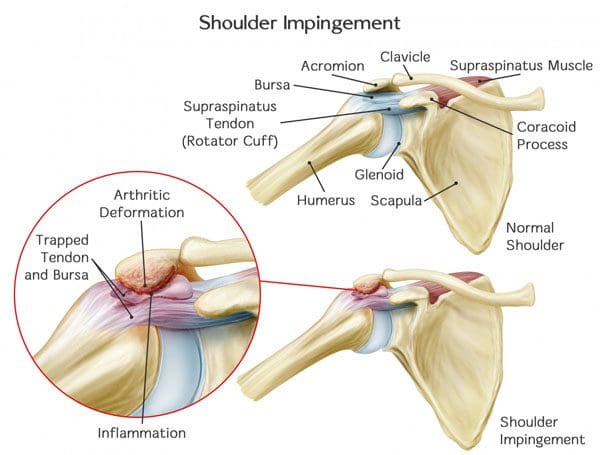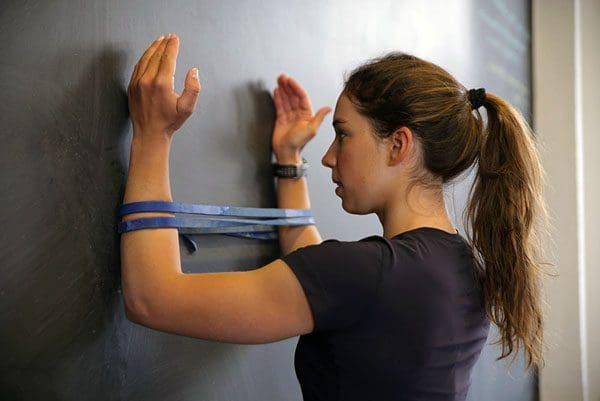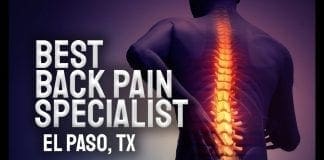The shoulder is subject to different irritations, injuries, and conditions. Shoulder impingement is a common ailment but is often confused with other shoulder problems. Properly treating impingement syndrome needs proper diagnosis first. Most shoulder impingement cases do not require surgery. Conservative treatment, like chiropractic, focuses on pain reduction while increasing the range of motion. This is achieved with manual manipulation, soft tissue therapy, cold laser therapy, and spinal adjustments for shoulder posture realignment.

Table of Contents
Shoulder Impingement Symptoms
Shoulder impingement often gets confused with a pinched nerve or a rotator cuff tear. The symptoms can be similar, but the treatment options differ. This is why it’s important to know the specific shoulder issue presenting. This can be done by recognizing the symptoms and performing a shoulder impingement self-exam. Symptoms include:
- Pain when lifting the arm straight out.
- Pain when lifting the arm overhead.
- Pain along the outside of the shoulder, the front, back, or side.
- Dull throbbing pain.
- Trouble sleeping, specifically individuals that sleep with their arm over their head.

Shoulder Impingement Self Exams
There are self-exams at home to help determine if it is shoulder impingement. These exams are for a better idea, but a professional chiropractic diagnosis is recommended.
Exam 1
- Take the hand of the affected arm and place it on the opposite shoulder, creating a V shape at the elbow.
- Keeping the hand on the opposite shoulder, raise the elbow straight out in front, bringing it up toward the face.
- If pain is present in the shoulder while moving the elbow up, then shoulder impingement could be possible.
Exam 2
- Stand up with hands down at the sides.
- Turn the hand of the affected shoulder inward so the thumb faces back instead of forward.
- Keep the thumb pointing backward, and raise the arm straight up in front and over the head.
- Note if there is any discomfort or pain.
- Bring the hand back down to the side.
- Next, turn the hand so that the palm is facing forward.
- Again, raise the arm in an arc, ending above the head.
- If pain presents while raising the arm with the thumb back but feeling relief with the palm facing forward, it is likely a shoulder impingement.

Chiropractic Relief
If there is some impingement, different treatment options exist. Many doctors treat shoulder impingement with injections and pain management. Studies show that conservative treatments, like chiropractic, have shown positive results for shoulder impingement cases.
Chiropractic improves joint function and mobility while treating the underlying root cause. A chiropractor will use a multi-approach depending on the cause. A combination of adjustments, anti-inflammatory protocols, and active-release techniques can be used.
Chiropractic Adjustment
One of the first things chiropractors look at is the spine. This is because poor posture, and slumping shoulders, can be a major contributors to impingement. Chiropractors perform a posture assessment and, if necessary, a spinal adjustment to achieve proper alignment is the beginning of getting the body back in balance.
Anti-Inflammation Protocols
Next is the shoulder itself. Deep tissue massage and anti-inflammation techniques like cold laser therapy or ultrasound can relieve pain and reduce inflammation. Once the pain has decreased, the chiropractor will move on to active release techniques.
Active Release Technique
Usually, the muscles or tendons become inflamed and irritated; the active release technique is used to separate scar tissue from the soft tissue. The active release technique is performed with a combination of movement and manipulation. This increases healing through proper blood flow and circulation.

Healing Naturally
Here is an example of a potential treatment plan. All treatment plans are different depending on the following:
- Individual Health
- Activity level
- Medical history
- Age
- Injury
Rest and Pain Reduction
- The first step in healing is rest. Individuals will be recommended to cease overhead arm activity and any activity that causes shoulder inflammation.
- Pain reduction treatment. This could be:
- Ultrasound
- Laser therapy
- Massage
- Other forms of pain relief and inflammation reduction
Adjustments/Alignment
- Chiropractic adjustments performed on the upper cervical spine, upper back, and shoulder area will address the overall cause.
- Posture assessments will determine if the spine needs adjusting and if it is a cause of the impingement.
Stretching Exercises
- A chiropractor or physical therapist will teach the individual stretching and strengthening exercises for the shoulder muscles.
- The exercises are also called shoulder impingement rehab protocols.

Rehab Protocol
The stretches and exercises are an essential part of the healing process. The specific exercises will depend on the individual’s specific treatment plan but are made to be gentle on the body without any special equipment. Call our chiropractic and physical therapy clinic to talk to a trained professional if you have any questions.
Body Composition
Strength Training
Strength training is a technique/method of improving the body’s muscular strength. This is achieved by gradually increasing the resistance force through free weights, machines, or body weight. This means the body gets stronger and more capable of performing regular work and sports activities without experiencing weakness, fatigue, discomfort, and pain. Examples could include:
- Carrying groceries or children
- Moving furniture, household objects, etc.
- Running
- Jumping
- Other physical activities
Strength training has numerous benefits, including:
- Increased physical performance
- Improved blood pressure
- Improved metabolism
- Reduced fat mass
- Increased bone strength/density
- Improved cognitive ability
- Prevention and management of type 2 diabetes
- Improved cholesterol levels
- Reduction of pain associated with chronic conditions
References
Garving, Christina, et al. “Impingement Syndrome of the Shoulder.” Deutsches Arzteblatt international vol. 114,45 (2017): 765-776. doi:10.3238/arztebl.2017.0765
https://www.healthline.com/health/active-release-technique#benefits
Professional Scope of Practice *
The information herein on "Chiropractic Shoulder Impingement Mobility Treatment" is not intended to replace a one-on-one relationship with a qualified health care professional or licensed physician and is not medical advice. We encourage you to make healthcare decisions based on your research and partnership with a qualified healthcare professional.
Blog Information & Scope Discussions
Welcome to El Paso's Premier Wellness and Injury Care Clinic & Wellness Blog, where Dr. Alex Jimenez, DC, FNP-C, a Multi-State board-certified Family Practice Nurse Practitioner (FNP-BC) and Chiropractor (DC), presents insights on how our multidisciplinary team is dedicated to holistic healing and personalized care. Our practice aligns with evidence-based treatment protocols inspired by integrative medicine principles, similar to those found on this site and our family practice-based chiromed.com site, focusing on restoring health naturally for patients of all ages.
Our areas of multidisciplinary practice include Wellness & Nutrition, Chronic Pain, Personal Injury, Auto Accident Care, Work Injuries, Back Injury, Low Back Pain, Neck Pain, Migraine Headaches, Sports Injuries, Severe Sciatica, Scoliosis, Complex Herniated Discs, Fibromyalgia, Chronic Pain, Complex Injuries, Stress Management, Functional Medicine Treatments, and in-scope care protocols.
Our information scope is multidisciplinary, focusing on musculoskeletal and physical medicine, wellness, contributing etiological viscerosomatic disturbances within clinical presentations, associated somato-visceral reflex clinical dynamics, subluxation complexes, sensitive health issues, and functional medicine articles, topics, and discussions.
We provide and present clinical collaboration with specialists from various disciplines. Each specialist is governed by their professional scope of practice and their jurisdiction of licensure. We use functional health & wellness protocols to treat and support care for musculoskeletal injuries or disorders.
Our videos, posts, topics, and insights address clinical matters and issues that are directly or indirectly related to our clinical scope of practice.
Our office has made a reasonable effort to provide supportive citations and has identified relevant research studies that support our posts. We provide copies of supporting research studies upon request to regulatory boards and the public.
We understand that we cover matters that require an additional explanation of how they may assist in a particular care plan or treatment protocol; therefore, to discuss the subject matter above further, please feel free to ask Dr. Alex Jimenez, DC, APRN, FNP-BC, or contact us at 915-850-0900.
We are here to help you and your family.
Blessings
Dr. Alex Jimenez DC, MSACP, APRN, FNP-BC*, CCST, IFMCP, CFMP, ATN
email: coach@elpasofunctionalmedicine.com
Multidisciplinary Licensing & Board Certifications:
Licensed as a Doctor of Chiropractic (DC) in Texas & New Mexico*
Texas DC License #: TX5807, Verified: TX5807
New Mexico DC License #: NM-DC2182, Verified: NM-DC2182
Licensed as a Multi-State Advanced Practice Registered Nurse (APRN*) in Texas & Multistate
Multistate Compact RN License by Endorsement (42 States)
Texas APRN License #: 1191402, Verified: 1191402 *
Florida APRN License #: 11043890, Verified: APRN11043890 *
* Prescriptive Authority Authorized
ANCC FNP-BC: Board Certified Nurse Practitioner*
Compact Status: Multi-State License: Authorized to Practice in 40 States*
Graduate with Honors: ICHS: MSN-FNP (Family Nurse Practitioner Program)
Degree Granted. Master's in Family Practice MSN Diploma (Cum Laude)
Dr. Alex Jimenez, DC, APRN, FNP-BC*, CFMP, IFMCP, ATN, CCST
My Digital Business Card
RN: Registered Nurse
APRNP: Advanced Practice Registered Nurse
FNP: Family Practice Specialization
DC: Doctor of Chiropractic
CFMP: Certified Functional Medicine Provider
IFMCP: Institute of Functional Medicine
CCST: Certified Chiropractic Spinal Trauma
ATN: Advanced Translational Neutrogenomics














